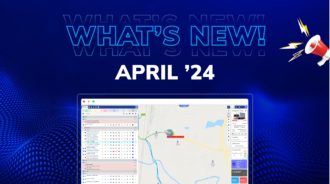In the realm of public and private transportation, ensuring the safety and efficiency of bus operations is paramount. With the growing emphasis on safety and sustainability, bus driver behavior monitoring software has become an indispensable tool for fleet managers. This powerful technology not only contributes to the safety of passengers and other road users but also aligns perfectly with the latest trends in expense management and operational efficiency. In this comprehensive blog, we will explore why bus driver behavior monitoring software is essential and how it integrates with advanced fleet management systems to optimize costs and enhance safety.
Understanding Bus Driver Behavior Monitoring Software
Bus driver behavior monitoring software is a sophisticated technology designed to enhance the safety and efficiency of bus operations by providing real-time insights into driver behavior. It utilizes a combination of hardware and software to collect and analyze data, while offering a comprehensive understanding of how drivers interact with their vehicles and the road.
Components of the Software
- Sensors and Cameras: These are installed in the bus to monitor various parameters. Cameras might focus on the road and the driver, while sensors can track vehicle movements, speed, and more.
- Data Analysis Tools: The software component analyzes the data collected by sensors and cameras. Using algorithms and sometimes AI, it interprets this data to identify patterns and anomalies in driving behavior.
- User Interface: This is the platform through which fleet managers and sometimes drivers themselves can view and interpret the data. It often includes dashboards, alerts, and reports.
Types of Behaviors Monitored
- Speeding: Monitoring if the bus is being driven at speeds above the set limits for the road or the fleet’s internal guidelines.
- Harsh Braking: Identifying instances of abrupt braking that might indicate tailgating or other dangerous driving habits also.
- Rapid Acceleration: Tracking instances of quick acceleration which can be unsafe and lead to increased fuel consumption.
- Sharp Cornering: Noting when turns are taken too quickly or sharply, which can be dangerous, especially for high-profile vehicles like buses.
- Idling Time: Monitoring how long the bus remains idle, as excessive idling wastes fuel and contributes to wear and tear.
- Seat Belt Usage: Ensuring drivers are wearing seat belts at all times while driving.
- Distraction and Fatigue: Advanced systems might also monitor signs of driver distraction (like phone usage) or fatigue (such as frequent yawning or eye closure).
How It Works
- Data Collection: The software continuously collects data from the various sensors and cameras on the bus.
- Data Analysis: The collected data is then analyzed in real-time. This analysis can identify patterns and behaviors that deviate from safe driving norms.
- Alerts and Reports: When a potentially dangerous behavior is detected, the system can alert the driver or send a report to the fleet manager. These alerts can be in real-time, providing an immediate nudge to the driver to correct their behavior.
- Long-Term Insights: Over time, the software builds up a profile of each driver’s habits. This can be used for personalized feedback, training, and development.
Why Monitoring Bus Driver Behavior is Crucial
Enhancing Passenger Safety
The foremost priority of any transportation service is the safety of its passengers. Monitoring software helps identify risky driving behaviors that could lead to accidents or uncomfortable rides. By addressing these behaviors, fleet managers can significantly reduce the likelihood of accidents and ensure a safer journey for passengers.
Reducing Operational Costs
Erratic driving behaviors such as harsh braking, rapid acceleration, and excessive idling can lead to higher fuel consumption and increased wear and tear on the vehicle. By identifying and correcting these behaviors, bus fleets can significantly reduce fuel costs and maintenance expenses, leading to more economical operations.
Promoting Responsible Driving
When drivers know that their behavior is being monitored, they are more likely to adhere to safe driving practices. This not only improves their performance but also fosters a culture of responsibility and safety within the organization.
Integration with Advanced Fleet Management Systems
Seamless Expense Management
Bus driver behavior monitoring software integrates seamlessly with advanced fleet management systems, particularly in the realm of expense management. By providing detailed data on driving patterns and vehicle usage, it allows for accurate tracking and allocation of operational costs. This integration ensures that every dollar spent is accounted for and used efficiently.
Data-Driven Decision Making
The integration of driver behavior data into fleet management systems allows for more informed decision-making. Whether it’s planning the most efficient routes, scheduling regular maintenance, or budgeting for fuel and repairs, the data provided by the monitoring software is invaluable.
Navigating the Trends in Transportation
Staying Ahead of Regulatory Compliance
Regulations in the transportation industry are continually evolving, with a growing focus on safety and environmental sustainability. Driver behavior monitoring software helps ensure that bus fleets comply with these regulations, thereby also avoiding fines and legal issues.
Embracing Technological Advancements
The transportation industry is at the forefront of technological innovation. By adopting driver behavior monitoring software, fleet managers are embracing the latest trends, while ensuring that their operations remain competitive and efficient.
Implementing Bus Driver Behavior Monitoring Software
Choosing the Right System
When implementing a monitoring system, it’s crucial to choose one that meets the specific needs of your operation. Consider factors such as ease of use, the type of data collected, and how well it integrates with your existing fleet management software.
Training and Support
For a monitoring system to be effective, drivers and fleet managers must understand how to use it properly. Comprehensive training and ongoing support are essential for ensuring that the system is used to its full potential.
Continuous Improvement
The implementation of driver behavior monitoring software is not a one-time event but an ongoing process. Regularly reviewing the data and using it to inform training and policy updates can lead to continuous improvements in safety and efficiency.
Benefits of Driver Behavior Monitoring
- Enhanced Safety: By identifying and correcting risky behaviors, the software contributes to a safer driving environment for everyone on the road.
- Cost Savings: Improved driving behaviors lead to reduced fuel consumption and wear and tear, saving money in the long run.
- Compliance: Helps ensure drivers comply with road safety regulations, reducing the risk of fines and legal issues.
- Improved Training: Data collected can be used to create targeted training programs, addressing specific areas where drivers need improvement.
- Accountability and Recognition: Provides a basis for recognizing exemplary driving behavior and addressing areas where drivers need to improve.
Conclusion
Bus driver behavior monitoring software represents a significant advancement in the pursuit of safer, more efficient transportation services. By providing real-time insights into driver behavior, it enables fleet managers to take proactive measures to enhance safety, reduce costs, and ensure compliance with regulatory standards. When integrated with advanced fleet management systems, it becomes an even more powerful tool, driving improvements in all areas of operation. As the transportation industry continues to evolve, bus driver behavior monitoring software will undoubtedly play an increasingly important role in shaping its future.



